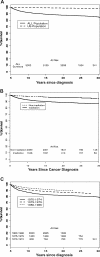Twenty-five-year follow-up among survivors of childhood acute lymphoblastic leukemia: a report from the Childhood Cancer Survivor Study
- PMID: 18334672
- PMCID: PMC2424150
- DOI: 10.1182/blood-2007-10-117150
Twenty-five-year follow-up among survivors of childhood acute lymphoblastic leukemia: a report from the Childhood Cancer Survivor Study
Abstract
Survivors of childhood acute lymphoblastic leukemia (ALL) are at risk for late effects of cancer therapy. Five-year ALL survivors (< 21 years at diagnosis; n = 5760 eligible, 4151 participants), diagnosed from 1970 to 1986 were compared with the general population and a sibling cohort (n = 3899). Cumulative mortality of 5760 5-year survivors was 13% at 25 years from diagnosis. Recurrent ALL (n = 483) and second neoplasms (SNs; n = 89) were the major causes of death. Among 185 survivors, 199 SNs occurred, 53% in the CNS. Survivors reported more multiple chronic medical conditions (CMCs; odds ratio [OR], 2.8; 95% CI, 2.4-3.2) and severe or life-threatening CMCs (OR, 3.6; 95% CI, 3.0-4.5) than siblings. Cumulative incidence of severe CMCs, including death, 25 years from diagnosis was 21.3% (95% CI, 18.2-24.4; 23.3% [95% CI, 19.4-27.2] and 13.4% [95% CI, 8.4-18.4] for irradiated and nonirradiated survivors, respectively). Survivors reported more adverse general and mental health, functional impairment, and activity limitations compared with siblings (P < .001). Rates of marriage, college graduation, employment, and health insurance were all lower compared with sibling controls (P < .001). Long-term survivors of childhood ALL exhibit excess mortality and morbidity. Survivors who received radiation therapy as part of their treatment or had a leukemia relapse are at greatest risk for adverse outcomes.
Figures



References
-
- Pui CH. Childhood leukemias. N Engl J Med. 1995;332:1618–1630. - PubMed
-
- Young JL, Jr, Ries LG, Silverberg E, et al. Cancer incidence, survival, and mortality for children younger than age 15 years. Cancer. 1986;58:598–602. - PubMed
-
- Gurney JG, Severson RK, Davis S, et al. Incidence of cancer in children in the United States: sex-, race-, and 1-year age-specific rates by histologic type. Cancer. 1995;75:2186–2195. - PubMed
-
- Reis LAG, Eisner MP, Kosary CL, et al., editors. SEER cancer statistics review, 1973-1998. Bethesda, MD: National Cancer Institute; 2001.
-
- Brenner H, Kaatsch P, Burkhardt-Hammer T, et al. Long-term survival of children with leukemia achieved by the end of the second millennium. Cancer. 2001;92:1977–1983. - PubMed
Publication types
MeSH terms
Grants and funding
LinkOut - more resources
Full Text Sources
Molecular Biology Databases

